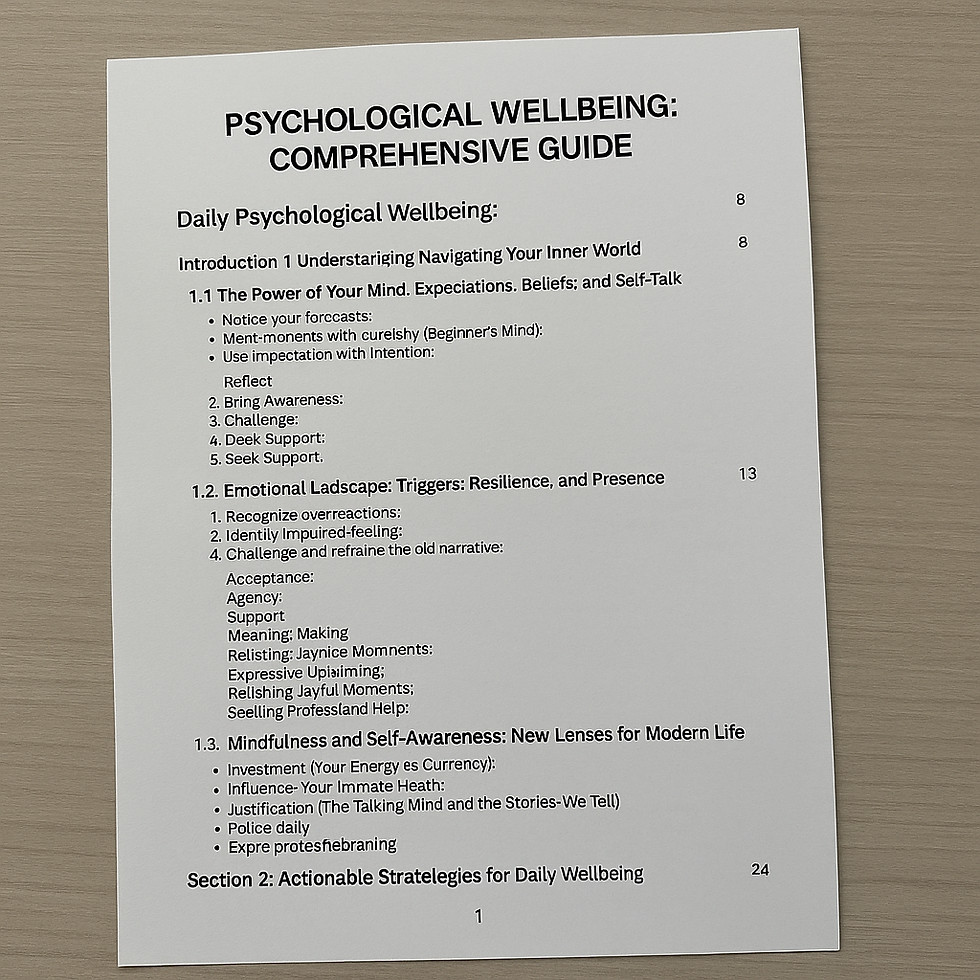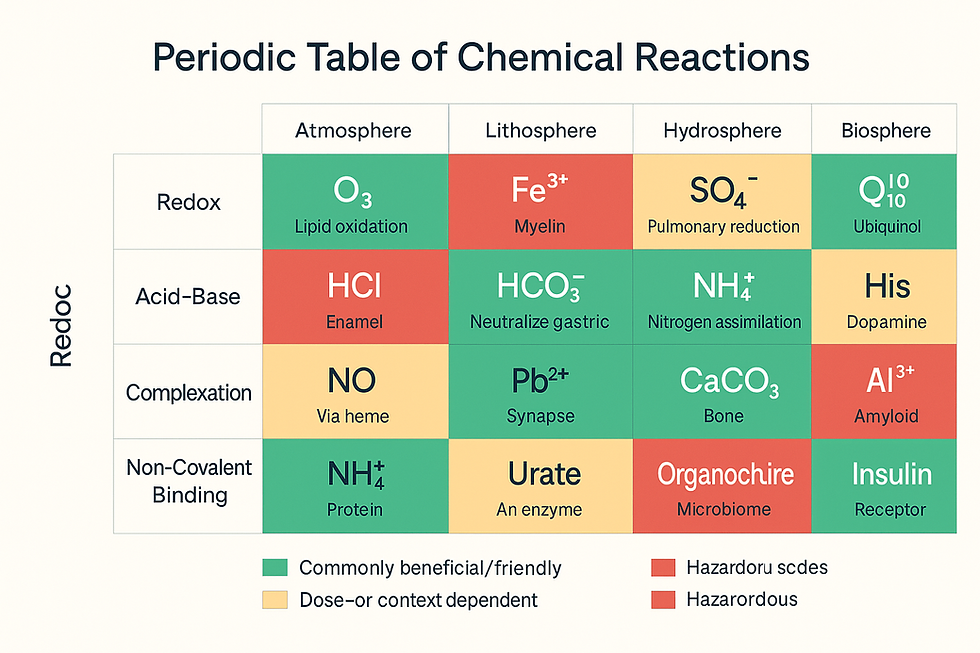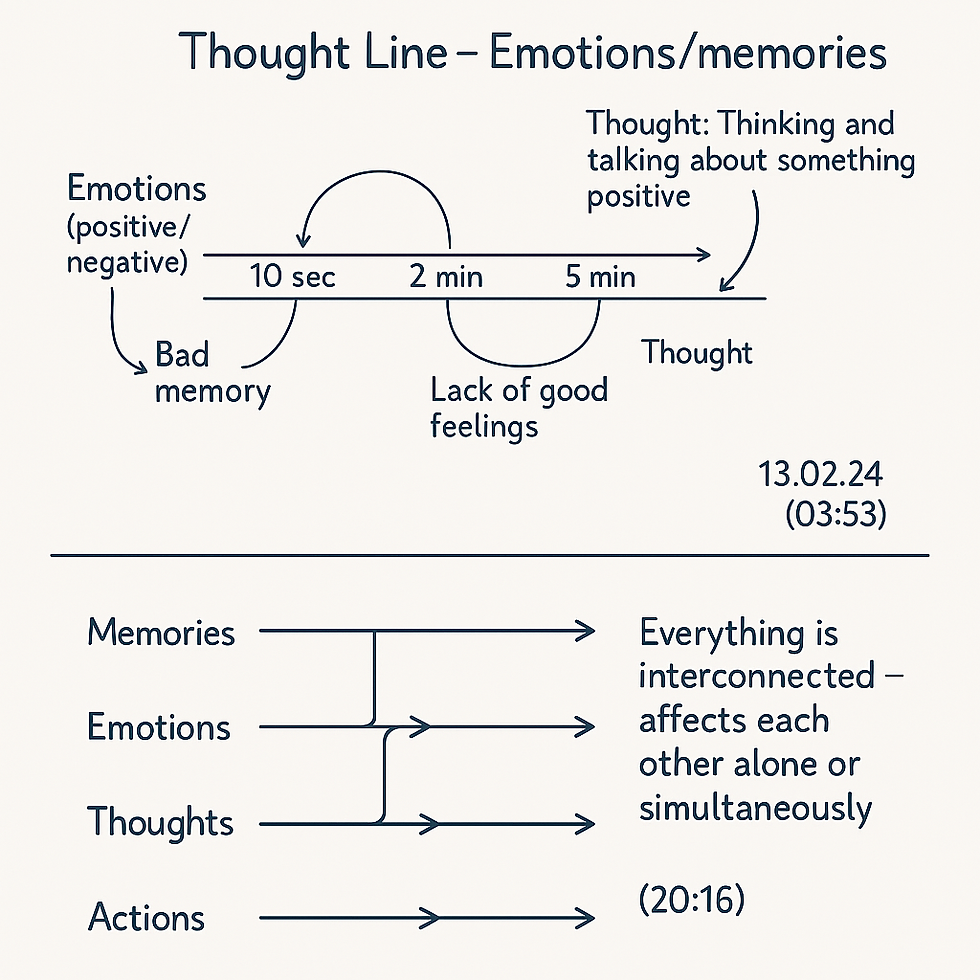Psychological Wellbeing, A Comprehensive Guide
- David B. N. J. & "A.I."
- Jun 7
- 5 min read

Download the blueprint/Guide here:
And,
Listen To The Podcast version here: (By NotebookLM)
The Foundation – Understanding Your Inner World
Your mind is not a passive camera; it's an active architect, constantly building the world you experience. The first step to greater well-being is understanding the blueprint it uses.
1. Your Brain's Forecast Shapes Your Reality
Your brain constantly makes predictions—or "forecasts"—about what's going to happen. Your feelings of satisfaction or disappointment are often determined by the gap between that forecast and reality, not just the event itself.
The Takeaway: You can't always control events, but you can manage your expectations.
Action Step: Before an important event, pause and ask: "What am I expecting right now?" Simply noticing your forecast loosens its grip. Approach moments with curiosity ("I'm open to seeing what happens") rather than rigid demands ("This must go perfectly").
2. Your Self-Talk Is Your Code
The words you use in your inner dialogue, especially phrases starting with "I am..." and "I can...", are direct lines of code for your self-concept. They aren't just descriptions; they are instructions that your mind follows.
The Takeaway: Your internal narrative actively creates your identity and your destiny.
Action Step: Shift your language. Instead of "I am bad at public speaking," try "I am learning to become a more confident speaker." Then, actively look for small pieces of evidence to support this new, empowering story.
3. Emotional Triggers Are Messengers from Your Past
An intense emotional reaction that seems disproportionate to the present situation is often a trigger—a messenger from an old, unhealed wound. When triggered, your rational adult mind can go offline, and you react based on past feelings, not present facts.
The Takeaway: Understanding your triggers disarms their power over you.
Action Step: When you feel an overwhelming reaction, pause. Name the core feeling (e.g., rejection, fear, shame). Gently ask yourself, "When have I felt this way before?" Connecting the feeling to its origin story helps you respond to the present with choice, not compulsion.
4. Mindfulness is Your Inner Compass (JII Dynamics)
A practical way to practice mindfulness is to observe your inner world through three lenses:
Investment: Where is my energy (time, attention) going? Is it on what's truly relevant to my values?
Influence: How do my relationships make me feel? Do I feel seen, known, and valued?
Justification: What story am I telling myself to make sense of my life? Is this story helping me grow or holding me back?
The Toolkit – Actionable Strategies for Resilience & Growth
Wellbeing isn't just about understanding; it's about doing. This page offers practical tools to navigate challenges, build genuine confidence, and actively cultivate a more positive state of being.
1. Make Better Decisions with a Simple Framework
Making good decisions is a skill, not a guessing game. Use this 6-step process to bring clarity to complex choices:
Frame: What is the exact issue? Is it mine to solve?
Explore: Brainstorm all possible options, even the uncomfortable ones.
Gather: What are the facts? What information am I missing?
Values: What principles (e.g., integrity, courage, compassion) are at play here?
Perspectives: Who else is affected? What would they say?
Justify: Choose the option that best aligns with your values and be ready to explain why.
2. Build Confidence Through Competence, Not Posing
Genuine, lasting confidence isn't about appearing bold; it's the quiet self-trust that comes from proven ability. Overconfidence can be fragile and lead to poor decisions.
The Takeaway: Confidence is the result of competence.
Action Step: Focus on skill-building. Seek structured feedback (even when it's hard to hear), adopt reflective practices to learn from mistakes, and invest in becoming genuinely good at what you do.
3. Embrace "Productive Discomfort"
The sweet spot for growth is just beyond the edge of your comfort zone. Clinging to comfort leads to stagnation. The discomfort you feel when trying something new and challenging isn't a sign to stop; it's the feeling of your capabilities expanding.
The Takeaway: Stop chasing comfort. Start building the future you want.
Action Step: Intentionally lean into "stretch experiences." Take on a project that scares you a little. Learn a demanding new skill. Focus on your progress, not on achieving perfection.
4. Actively Cultivate Positive States
Happiness and gratitude aren't just happy accidents; they are practices that require intentional effort to counteract the brain's natural "negativity bias."
Create a "Happiness Plan": Don't wait for happiness to arrive after a big achievement. Intentionally schedule small, "full-hearted pleasures" into your week (e.g., 20 minutes for a creative hobby, a walk in nature, or connecting with a friend).
Practice Gratitude: Every day, identify three specific things you are grateful for. This simple act trains your brain to scan for the positive, building resilience and hope.
The Connection – Living with Purpose in the Modern World
A fulfilling life is lived in connection—with others, with your values, and with the present moment. This final page is about integrating your inner work with the world around you.
1. Prioritize Connection to Combat Loneliness
The quality of your relationships is one of the strongest predictors of long-term health and happiness. Loneliness isn't just a feeling; it's a critical health issue, with research showing it impacts those with fewer economic resources most severely.
The Takeaway: Social connection is a vital resource. Nurture it.
Action Step: Invest time and energy in your relationships. Consider that reading fiction can also boost empathy and reduce feelings of loneliness by connecting you to the shared human experience.
2. Rise Above "Hustle Culture"
The relentless societal pressure to "do more and be more" is a recipe for burnout and anxiety. Your worth is innate; it is not defined by your productivity or your job title.
The Takeaway: Live an authentic life aligned with your values, not society's prescriptions for success.
Action Step: Redefine what achievement means to you beyond your career. Schedule self-care as a non-negotiable priority. Clarify your core values and make choices that honor them, even if it means slowing down.
3. Play the "Infinite Game" of Life
There are two ways to approach life:
Finite Players play to win. They follow rules, seek to end the game with a victory, and avoid uncertainty.
Infinite Players play for the love of the game. Their goal is to keep playing. They embrace uncertainty as an opportunity for learning and renewal.
The Takeaway: Fulfillment comes from the process, not just the outcome.
Action Step: Approach your life as an infinite player. Focus on learning, collaboration, and possibility. Redefine success as enjoying the journey and helping others continue their own.
4. Practice "Micro-Moments of Arrival"
Much of our suffering comes from a "treadmill mentality"—constantly striving for a future moment when we believe we will finally be at peace. The truth is, you don't need to wait.
The Takeaway: You have already arrived.
Action Step: Integrate small pauses of genuine presence into your day. Sip your coffee without checking your phone. Greet a friend with your full attention. Allow yourself to simply be for a moment. These "micro-moments of arrival" are where life is truly lived.





Comments